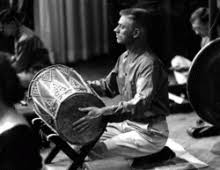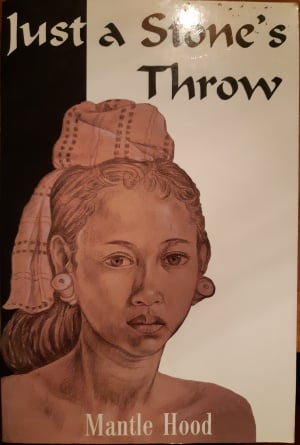- Full Name
- Mantle Hood
- Pen Name
- Mantle Hood
- Photograph by
- UCLA
- Link to Photograph
- https://www.ethnomusicologyreview.ucla.edu/content/highlights-ethnomusicology-archive-mantle-hood-collection
- Website for biography
- Place
- Related Music
- Related Books
- Related Scholars Articles
Biography
In English
Professor, Pioneer in Studying World’s Music and Cultures (1918-2005) “Mantle Hood was the first scholar to take seriously the study of what was then called nonWestern music, in the 1950s,” said Christopher Waterman, dean of UCLA’s school of arts and architecture and an ethnomusicologist. Hood joined the UCLA faculty in 1956 and created what is now the department of ethnomusicology in 1960. He envisioned a complete approach to the study of his field. He wanted students to learn at least two music traditions, their own and that of a culture new to them. He also urged them to learn to play a native instrument, drums for a student of West African music, for example. Common practice now, it was considered novel when he introduced the idea, which he referred to as bi-musicality. By learning several music traditions, Hood proved that the two could exist in harmony, according to Jacqueline Cogdell DjeDje, chairwoman of UCLA’s ethnomusicology department. (...) "Hood saw it as a way to teach students respect and understanding for “people and cultures different from their own,” DjeDje said. Hood also expected his graduate students to see and hear the music they studied as it was performed in its native setting. “Hood taught that the music comes out of the culture,” said Robert Garfias, professor of anthropology at UC Irvine and one of Hood’s first graduate students at UCLA. “His idea was to study the music as part of the culture.” Hood had been traveling the world from the time he graduated from UCLA in 1951 after earning a bachelor’s and a master’s degree in music. He received his doctorate from the University of Amsterdam, where he wrote a dissertation on Javanese music. After joining the faculty at UCLA, he was granted a Ford fellowship that allowed him to live in Indonesia for two years and study its music. He later studied in India on a Fulbright fellowship. An expert in the music of Java and Bali, Hood played all the instruments in a gamelan, an Indonesian symphony that consists of percussions, winds, strings and other instruments. During gamelan performances with his students, he played the rebab, a type of lute that is the lead instrument in the ensemble. Dozens of his UCLA students went on to teach ethnomusicology. Several of them founded programs at universities, including UC Berkeley. “Hood had a very powerful impact on how ethnomusicology is taught,” said Garfias, who founded a program at the University of Washington, Seattle, before moving to UC Irvine. Hood was born in Springfield, Ill., and moved to Los Angeles with his mother in the 1930s after his father died. He played piano and later learned the saxophone but didn’t expect a career in music. After high school, he worked at various jobs including as a draftsman at McDonnell Douglas. He also played saxophone in jazz bands. He served in the Army during World War II and returned to Los Angeles in 1945. After a false start as an agriculture student at UCLA, he found his true calling. Before he left the university in 1975, he wrote several books about his field, including “The Ethnomusicologist” (1971), which outlined research issues and questions related to what was then considered a new subject of study. An ethnomusicologist, Hood wrote, “is inclined to be highly sensitive to other human beings, to respect their scales of values and their behavior, even if these are not compatible with his own.” Hood moved from Los Angeles to Hawaii in 1973 and began to write self-published novels. “As a young man, he had his heart set on being a writer,” Marlowe Hood said. “As a teenager, he loved pulp fiction.” He set his potboilers in countries he had visited over the years. “Just a Stone’s Throw” is set in Bali. “The Keepers” is set in Hawaii and Japan. In 1980, he relocated to Maryland where he established an ethnomusicology program at the University of Maryland, Baltimore County. He wrote several more books about ethnomusicology and continued teaching until 1996. (...) He has four sons.
Amazon: Author of fiction:
Mantle Hood is the published author of seminal works in the field of ethnomusicology, study of the musical cultures of the world. A pre-eminent international scholar, he is the principal author/co-author of more than 20 books, was member of the Board of editors for the prestigious New Grove Dictionary of Music and Musicians (6th ed.) and has contributed to music dictionaries in four languages. Along the way, he has served as Distinguished Professor of Music from West Coast (UCLA) to East Coast (Harvard, Yale, Wesleyan Universities, and the University of Maryland), University of Hawaii, and institutions in Europe, Africa an Asia. He is a fellow of the East-West Center of Arts and Sciences. He has studied the music of peoples the world over, including Asia and the Pacific Islands. As a resident of Hawaii and visitor to Japan he developed an idea based on a newspaper article, one that blossomed into his first suspense novel, The Keepers. One agent described Hood's suspense fiction as a combination of John Grisham and James Michener.In Balinese
In Indonesian
Los Angeles Times https://www.latimes.com/archives/la-xpm-2005-aug-09-me-hood9-story.html?









Enable comment auto-refresher